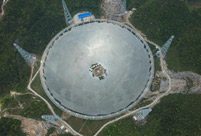

 |
| (File Photo) |
China plans to launch a data relay satellite into Halo orbit near the Lagrange point L2 of the Earth-moon system at the end of May or in early June of 2018 and furthermore will send the Chang'e-4 probe to the dark side of the moon about half a year later to explore the South Pole-Aitken basin, said Liu Tongjie, deputy chief of China's lunar exploration.
After the launch, a data relay satellite will ensure communication between Earth and the lunar probe during an expedition to the far side of the moon, said Liu.
Due to gravitational forces, this part of the moon is not visible to Earth and has never been explored by humans. So the data relay satellite will be launched six months before the probe.
Earth can contact Chang’e-4 with the help of a “communication station” at the Lagrange point L2 of the Earth-moon system, 80,000 kilometers away from the moon.
The South Pole-Aitken basin is the largest known impact crater in the solar system at nearly 2,500 kilometers wide and 13 kilometers deep.
The unique environmental conditions and complex geological history has long been a puzzle, a hot issue and a point of focus for academic and engineering circles.
Currently the National Aeronautics and Space Administration (NASA) and the European Space Agency (ESA) have been developing plans to explore the dark side of the moon. The ESA has put forward detailed proposals of exploration and plans to implement the plan in 2025.
 Five made-in-China hi-tech breakthroughs
Five made-in-China hi-tech breakthroughs Beijing Style: Hot pants
Beijing Style: Hot pants HK-Zhuhai-Macao Bridge to open to traffic
HK-Zhuhai-Macao Bridge to open to traffic China opens its first combined transport service to Nepal
China opens its first combined transport service to Nepal Students take stylish bikini graduations photos
Students take stylish bikini graduations photos Charming dancing students pose for graduation photos
Charming dancing students pose for graduation photos Guizhou, Yunnan section of Shanghai-Kunming railway connected
Guizhou, Yunnan section of Shanghai-Kunming railway connected Naked models transformed into landscapes, birds and even DRAGONS by body painting artist
Naked models transformed into landscapes, birds and even DRAGONS by body painting artist World’s biggest cruise ship Harmony of the Seas to start maiden voyage
World’s biggest cruise ship Harmony of the Seas to start maiden voyage Top 20 hottest women in the world in 2014
Top 20 hottest women in the world in 2014 Top 10 hardest languages to learn
Top 10 hardest languages to learn 10 Chinese female stars with most beautiful faces
10 Chinese female stars with most beautiful faces China’s Top 10 Unique Bridges, Highways and Roads
China’s Top 10 Unique Bridges, Highways and Roads US embassy car blamed for injuring woman
US embassy car blamed for injuring woman Why does Japan fear close Sino-Russian ties
Why does Japan fear close Sino-Russian ties ‘China refugee’ insult video slammed in Taiwan
‘China refugee’ insult video slammed in Taiwan A call to adjust affirmative action in China’s gaokao
A call to adjust affirmative action in China’s gaokaoDay|Week